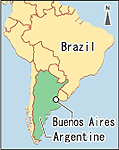(7) Smiling on "Peace Day" in a Japanese garden by Tomoko Aikawa
In Argentina, on the other side of the world from Japan, Hiroshima and peace are synonymous.


(above): People in Buenos Aires enjoy walking in the Japanese garden and experiencing Japanese culture.
(below): Bell of World Peace
Tomoko Aikawa
Born in Hiroshima, she moved to Buenos Aires in 1991. She works as a Spanish interpreter and translator and a consultant in photography projects. Through her work, she seeks to build bridges between Argentina and Japan.
Buenos Aires has many immigrants from Japan so there is a Japanese garden in Palermo. It was made by Japanese immigrants to show their gratitude for people who welcomed them in the town. You can see a red, Japanese-style bridge, pine trees and azaleas in the garden, and a large temple bell.
It is called the "Bell of World Peace," and like the Peace Bell in the Japanese garden at UN Headquarters in New York, it is made of coins contributed from around the world and transformed into the bell to ring for peace.
1998 was the 100th-year anniversary of friendship between Japan and Argentina, and so various events were held. First, on February 3rd, was the presentation of the hall which houses the bell. It was built from donations made by 30,000 fourth- and fifth-generation Japanese immigrants.
Since then, on every "UN Peace Day," the bell can be freely rung while praying for peace. (Normally, the bell cannot be handled.) When people are ringing the bell, they can imagine the city of Hiroshima in the distance.

The UN Peace Day was originally September 11, but after the terrorist attack on the same day, since 2002 the date has been September 21st. In Argentina, located in the southern hemisphere, it is a Spring day. And as this day also marks the Vernal Equinox and Students Day, there are no classes at the university and students can enjoy a picnic in the park. In the Japanese garden, young people smile and chat next to colorful azaleas in full bloom.
The image of Peace Day is bright and joyful. At the same time, the people of Buenos Aires visit the Japanese garden to feel a sense of peace.
In the garden, there is also a stone from the bombing of Hiroshima that was donated in 1995. This stone came from along the railroad tracks and the image of Kannon was carved into it. In Spanish, Kannon can be translated as the "Goddess of Mercy."
Incidentally, I recently had the opportunity to go to the South Pole in my work for a Japanese TV station. In the South Pole, many countries have bases and staff who cooperate in researching environmental changes--work that crosses national borders. It is a pure space, a sacred space, and I think the South Pole and Peace Seeds have this in common.